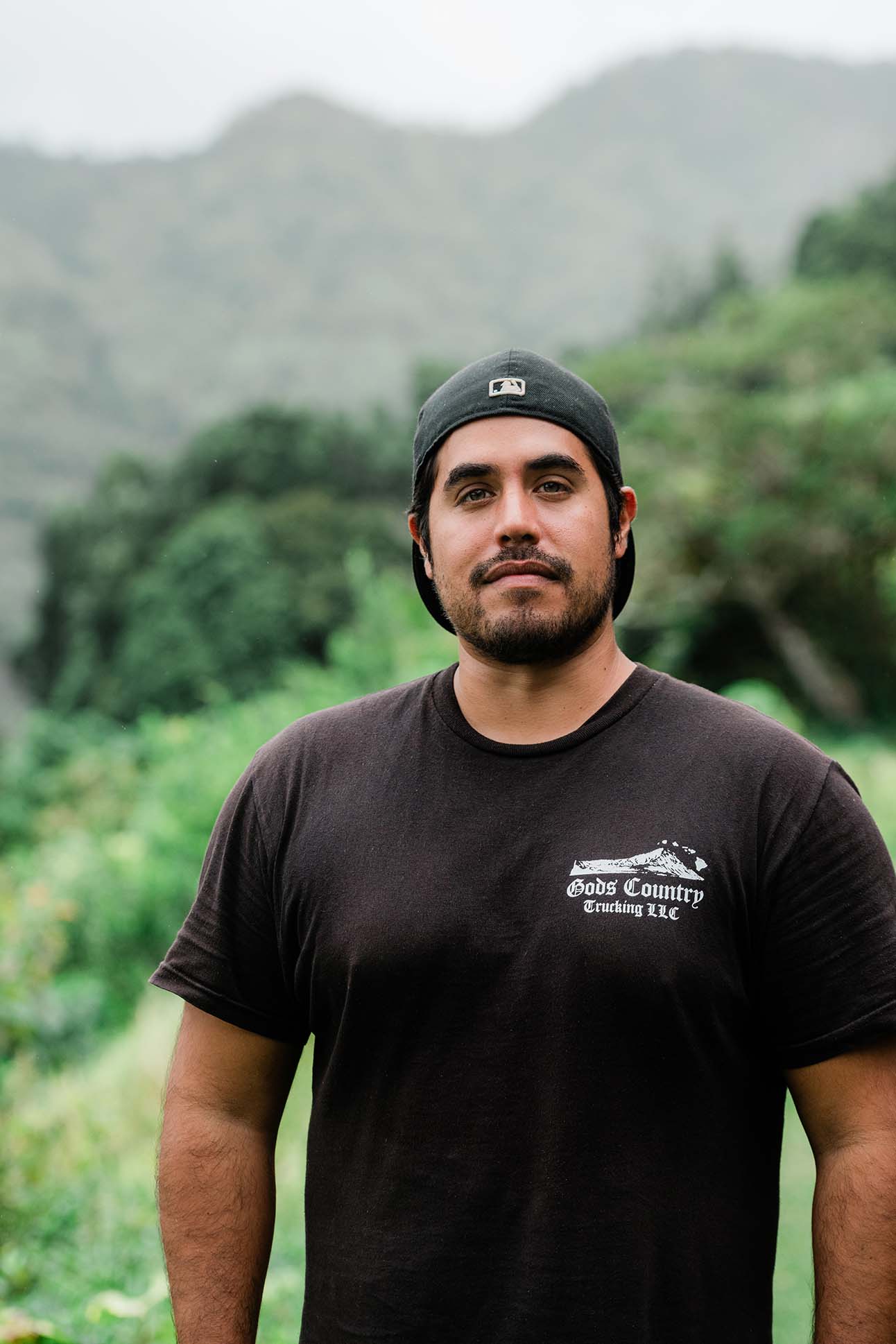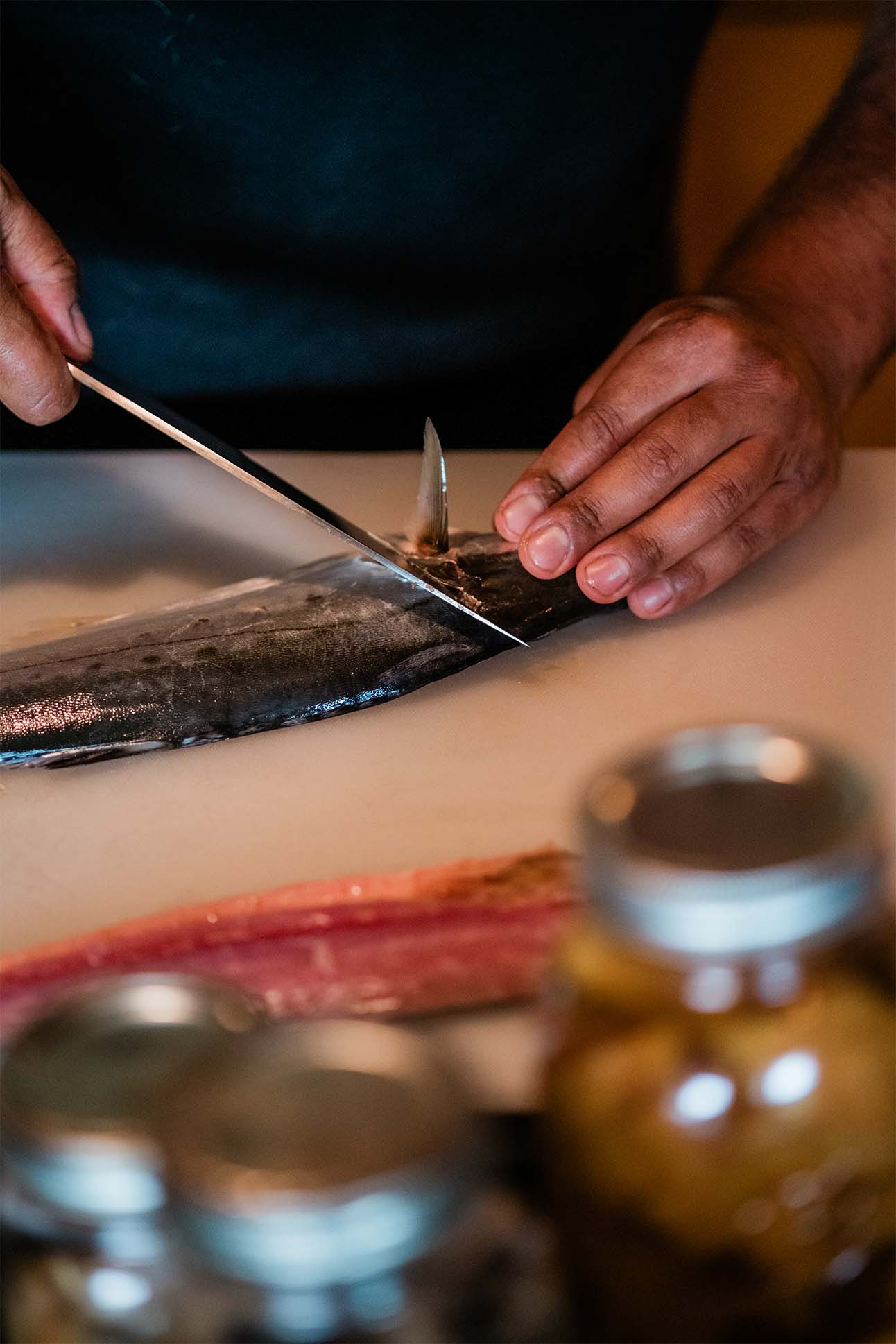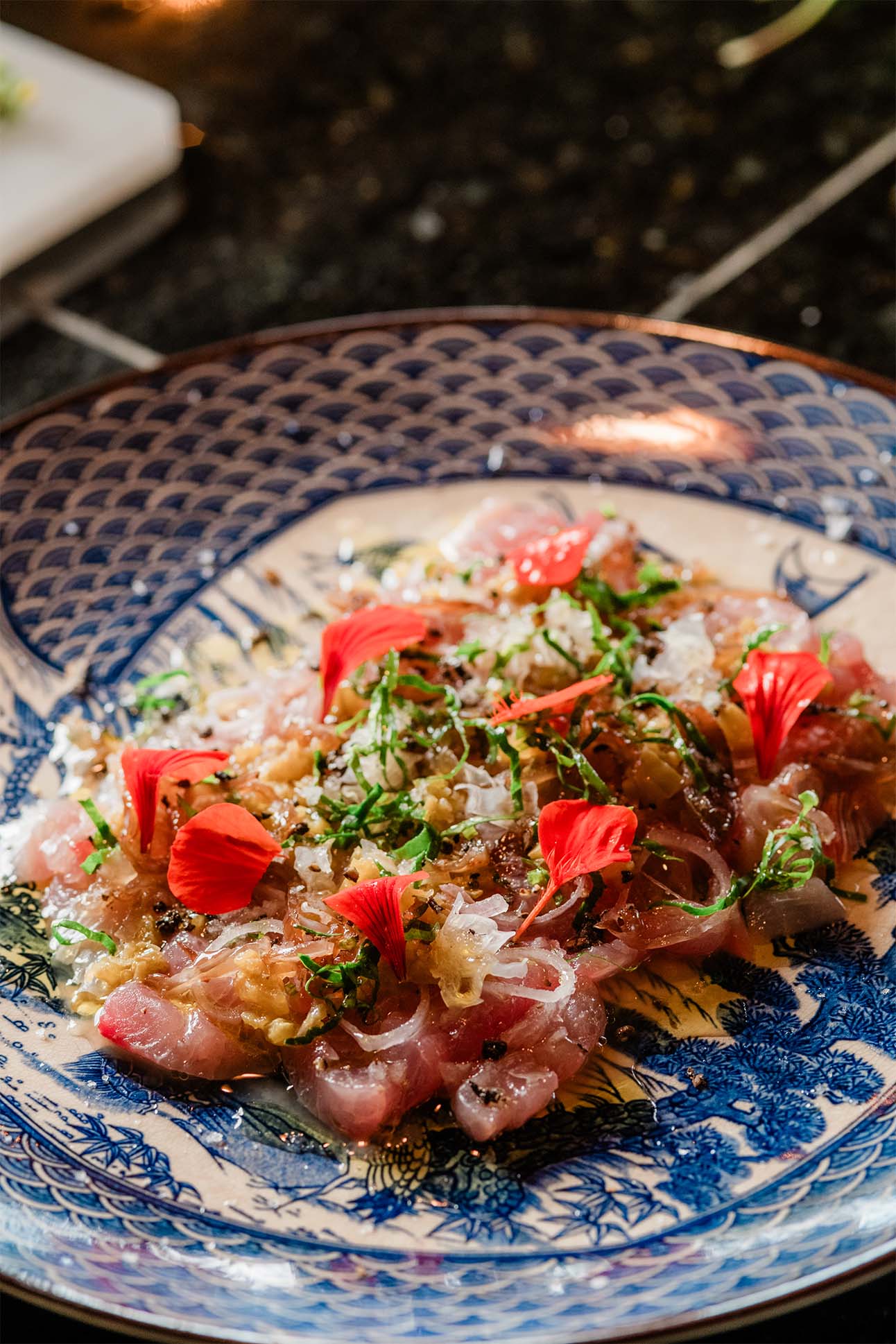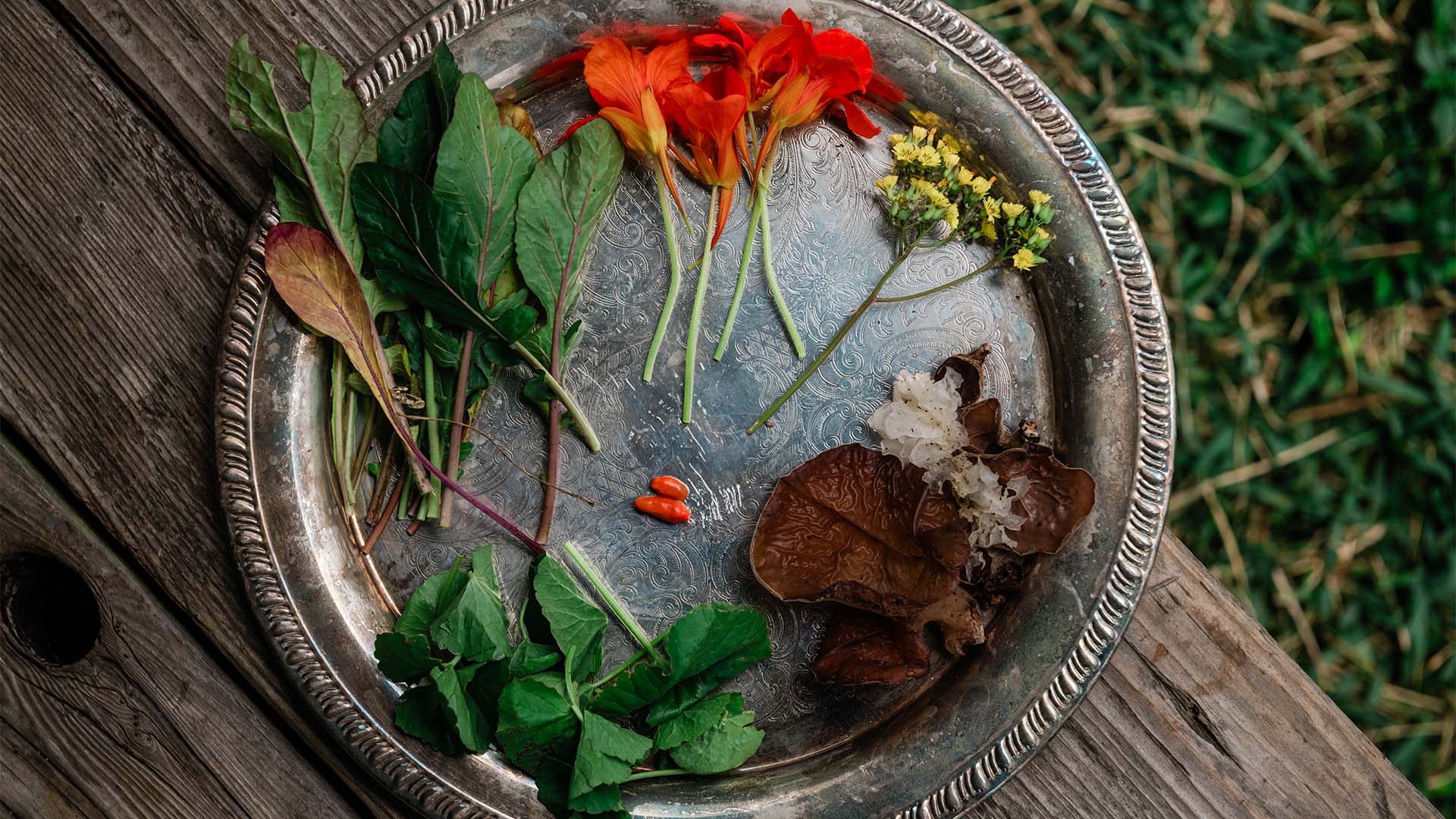Through private dinners and foraging classes, local chef Yuda Abitbol has turned his gastronomical journal into a wildly self-sustaining lifestyle.
Images by John Hook
The first time Yuda Abitbol went foraging in Hawaiʻi, he almost died. He was 19 years old, living a fast life in Waikīkī, when he met a girl who invited him to go on a hunt for angel trumpet flowers. A stranger on the beach had told her the flowers could produce psychedelic effects similar to mushrooms, and Abitbol was game to try.
After all, he was accustomed to ingesting mind-altering plants. His mom was from Chihuahua, Mexico, where peyote natively grows. In her indigenous culture, the plant was used as medicine. She had taken it her whole life, even after she moved to Oʻahu while pregnant with Abitbol, who was born in Kahaluʻu in 1992. When his parents divorced five years later, he moved to California with his mom, who sold shawls at powwows. On the weekends, they would join tribal members on the La Jolla reservation to forage berries and miner’s lettuce and catch crawfish in creeks and ponds. Abitbol inherited a calabash grandfather who was an Arapaho medicine man from Wyoming, and his family was invited to attend tribal rituals, staying up all night listening to mythical stories. He said he was five the first time he took peyote at one of the ceremonies.
But the angel trumpet tea put Abitbol in a coma for five days. “The best way to describe it is you take 20 tabs of acid and get bit by a rattlesnake and you just begin to die while you’re tripping out,” Abitbol said. “That girl sent me down to hell. In Native American myths, that plant is used to wipe away your spirit. It’s like hitting a refresh button — if you make it out.”


When Abitbol awoke, all he could think about were plants: How they functioned in the wild, how they were related to each other, how they are used, where he could find them in nature. His new obsession came with an awakening: He needed to get his life in order.
For years, he worked the hot line in Honolulu kitchens starting at a grimy burger truck in Waikīkī and eventually at Fête, 53 by the Sea, and Herringbone. But it was during a stint as a roofer in Hanapēpē, Kauaʻi, when he was 26 years old, that he developed a passion for local ingredients. There, he stayed with his best friend’s uncle, who cared for salt flats by day, and by night put beers on ice and prepared dinner for them — dishes like fresh aku sashimi and poke or Samoan crabs stir-fried in a wok. For breakfast, the uncle would make smoked meat with eggs from his chickens and homemade wai nīoi, or chili pepper water. At work, guys from Niʻihau told Abitbol stories about picking endemic ʻopihi and catching ‘ahi from the shore. When his friend’s uncle sent Abitbol home to Honolulu with two Ziploc bags of salt from his ‘ohana’s flats, Abitbol was ready to start developing his own cooking style.
These days, Abitbol lives on the mauka side of Pālolo along Pūkele Stream with his dog, Hōʻiʻo. Here, he grows herbs, canoe crops, and tropical fruit. Gotu kola, kava, and cinnamon grow wild behind his home. Steps away, he forages wood ear mushrooms and, if he’s lucky, traps a pig. Inside, jars of honey, pickles, dried peppercorns, and freshly harvested salts line his shelves. There are locally grown grapes in the freezer, pickled star fruit from his backyard and Korean cheong made of sea grapes in the fridge, and a jar of white peaches from Kōkeʻe, Kauaʻi bubbling their way to kombucha on his counter.


This is all fodder for Abitbol’s private foraged dinners, which he started offering in 2021. The meal may include a crudo of local kala garnished with ‘ākulikuli, wild fennel, and limu; a fresh pasta showered with bottarga he makes with ‘ōmilu (bluefin trevally) he spearfished, or a salad made of crunchy hōʻiʻo ferns with wild chestnuts and snow fungus. You might sit at a table covered in live moss and fresh flowers alongside oyster shells filled with Norfolk pine sap for candles. At the end of the meal, you may inhale the smoke of petrified sandalwood to evoke the forest where most of your meal came from.
The sensory and decorative touches are inspired by time Abitbol spent in France. When he was 14, he moved back to Hawaiʻi to live with his French-Moroccan dad and the pair took regular trips to his Parisian birthplace. What impressed Abitbol most about the French was their attention to detail when setting a table. There were elaborate centerpieces and particular silverware and glassware for each dish. “[Eating is] like a little ritual to them,” he said. “In France they cherish their table. I try to instill that into my dinners.”
For the chef, everything starts with salt and pepper. Once he has harvested those, it’s about what he can gather that won’t put too much strain on the species. He has protocols, like asking the gods for permission to enter new spaces, leaving offerings, and bringing gifts to fellow foragers. “I don’t just get off the airplane and help myself to this and that,” he said. “I have a friend in the zone I’m going to, and I always bring gifts for them like salt, pepper, cinnamon, so there’s an exchange.”
The center focus is foraging, the ingredients, and storytelling.
Yuda Abitbol

The first intention he had when he started foraging was not to overharvest. A perfect example is his ‘opihi pasta. He’ll turn the black-foot limpet into a compound butter to toss the noodles in instead of giving each guest their own ‘opihi, so he can stretch what he has and harvest less.
In 2023, Abitbol also began offering foraging classes. He developed his expertise by following tips about wild foods often shared by local kūpuna or kids. From there, he goes hunting for information in the library. Only after he has learned everything he needs to know about the ingredient, including what kind of environment they thrive in and how and when they came to Hawaiʻi, does he go looking for it in nature.
But he never goes searching for only one thing. “If I do, I never find it,” he said. Once, he was foraging for Slippery Jack mushrooms and came upon ʻākala berry, which he’d been hunting for three years. The brave and curious can learn about Abitbol on his Instagram account called @followsthewai, a gastronomic journal of his discoveries, dinners, and off-grid excursions over the years. But don’t think finding foraging information will be easy. Abitbol purposely leaves his posts uncategorized and slightly vague. “If you want to learn about something, you have to look through the journal to find it,” he said. “You have to put in some groundwork, the same way I did.”
The same goes for booking a dinner. “I want to know who wants the dinner and why,” Abitbol said. “I’m pretty picky with people.” A banquet for 40 people would be out of Abitbol’s scope, but an intimate dinner for six hunters would be on the mark. “The center focus is foraging, the ingredients, and storytelling,” he said.

